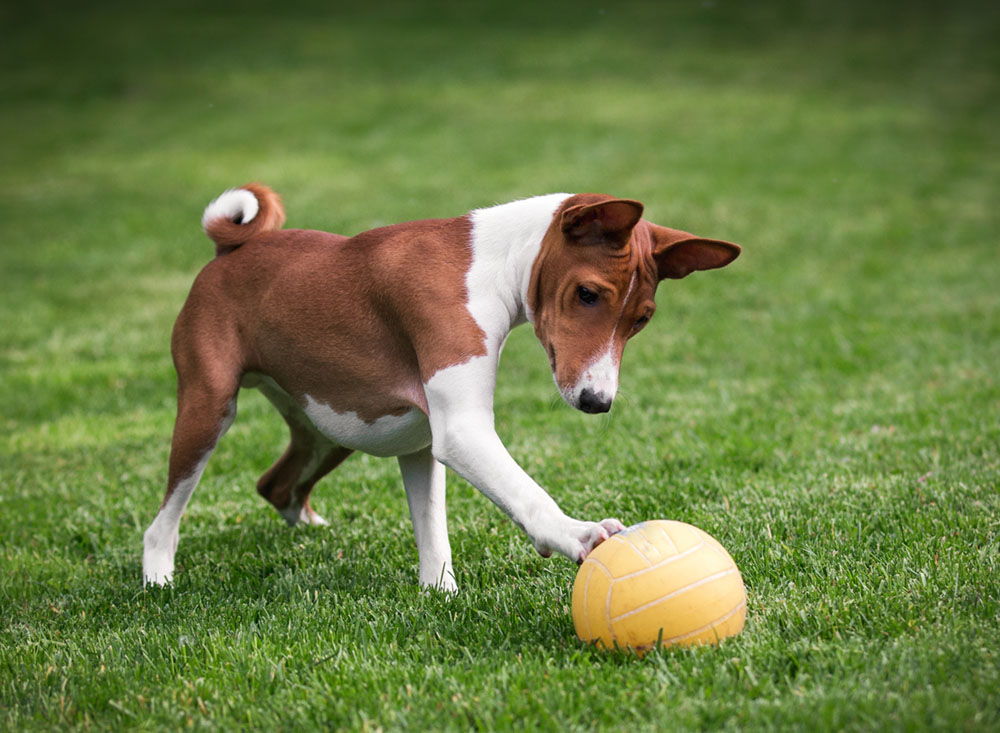Breed Profile – Basenji
14/07/2017
The Basenji is a primitive hunting hound from Africa. Thought to descend from Ancient Egypt originally, this interesting breed yodels instead of barking and has a rather interesting tail!
Origin of Breed: The Basenji descends from ancient breeds, making this sight and scent hound one of a group of primitive breeds. In fact, there are paintings of strikingly similar dogs in Egyptian tombs. The main use for the breed is hunting small game or driving big game. They arrived in the UK from the African Congo in the 1930s, the name meaning ‘village dog’ in Lingala, the language of the Congo. They have a funny habit of standing on their hind legs in curiosity and are famous for yodelling rather than barking, also known as a ‘baroo’.
Life Expectancy: About twelve years.
Size: A small dog with a height range of 40-43cm and a weight range of 10-11kg.
Features: A light, fine-boned dog, high at the leg in proportion to length. Poised and elegant, with an athletic, graceful gait said to be like a gazelle. The Basenji has a flat-topped skull, tapered towards the nose. The forehead wrinkles when the dogs pricks its ears. Their ears are small, pointed and slightly hooded, which contributes to their alert expression. Legs are long and straight with the tail carried high over the back in a tight curl. The Basenji’s coat is short, sleek and fine and comes in black and white, red and white, black, tan and white and brindle. Rarer is the ‘trindle’ coat; tricolour with brindle features. White should be on the feet, chest and tail tip. White blaze, collar and legs are optional.
Energy Levels/Exercise Required: Basenjis require about one hour of exercise per day and particularly enjoy activities that mimic their natural hound instincts. They love to climb. An energetic small to medium dog like the Basenji needs a nutritionally balanced diet that will provide all they need to keep them going. Gilpa Trinkets has high protein levels and a high content of essential fats and oils for an active working dog. Furthermore, the biscuit sizes are smaller to suit the mouth size of small and medium breeds. A less active Basenji may prefer Dr John Silver with Chicken or Beef, which has lower protein levels and a lower fats and oils content.
Potential Health Problems: The Basenji is very prone to Fanconi syndrome, an inherited disorder of the renal tubes. The syndrome leads to a failure to reabsorb electrolytes and nutrients. It usually starts between 4-8 years, but can start as early as 3 years or as late as 10 years. It is possible to avoid organ damage by catching it early. A simple monthly glucose test with strips used for human diabetics detects the onset of the syndrome. Once detected, treatment is simple and effective.
This breed is also prone to eye problems, especially progressive retinal atrophy, hypothyroidism, malabsorption and genetic haemolytic anaemia.
Temperament: A highly intelligent and alert breed, affectionate with those familiar to it, but wary of strangers. The Basenji tends to be loyal to one family member in particular. They are independent and can be difficult to train, needing an experienced owner to handle them.
Family Dog/Child Friendly: With their energetic, intelligent nature, Basenjis are happy in a busy household that enjoys a variety of outdoor activities. Adults should always supervise dogs and children. If socialised early, the Basenji is okay with children, but might be happiest in a family with older children and teenagers. They instinctively chase other non-canine pets and are not suitable for a home with other pets. They do not need lots of space, so can be fine in a smaller home with a smaller garden or yard as long as they have regular exercise.
Likes: Exercise, especially climbing, and chasing ‘prey’.
Dislikes: Strangers, wet weather!!
- Categories
- A Dog's Life
- Arkwrights Beef
- Arkwrights Chicken
- Breed Guides
- Dog Nutrition & Health
- Dog Shows & Events
- Dr John Gold
- Dr John Grain-Free
- Dr John Hypo Lamb and Rice
- Dr John Hypoallergenic
- Dr John Puppy
- Dr John Silver Beef
- Dr John Silver Chicken
- Dr John Titanium
- G & P Dog Feeds
- Gilpa Kennel
- Gilpa Slimline
- Gilpa Super Mix
- Gilpa Trinkets
- Gun Dogs
- Latest Articles & News
- Other Dog Articles



